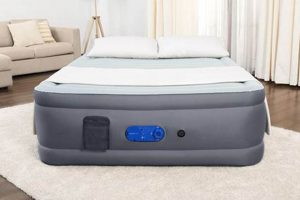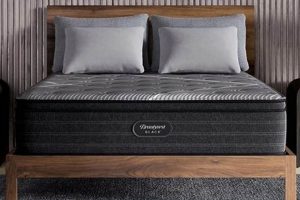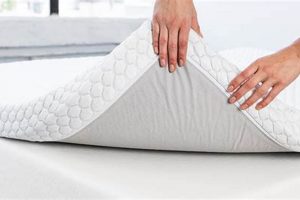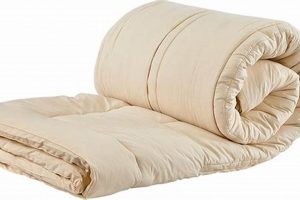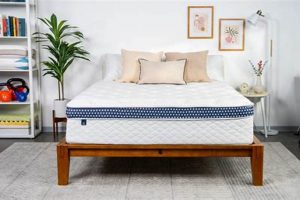A sleeping surface specifically designed to accommodate individuals of substantial size, or two people whose combined weight exceeds the capacity of standard mattresses, offers enhanced support and durability. Such mattresses are engineered to distribute weight evenly, minimizing pressure points and preventing premature sagging. A common example includes models incorporating reinforced coils and high-density foam layers.
The advantages of selecting a suitable mattress for heavier individuals or couples are manifold. Improved spinal alignment, reduced motion transfer, and increased longevity are among the key benefits. Historically, mattress construction focused primarily on accommodating average weights. Modern advancements in materials science and engineering have led to the development of mattresses tailored to meet the specific needs of a broader range of body types and sizes, promoting better sleep quality and overall well-being.
The subsequent sections will delve into critical factors to consider when selecting such a product, including material composition, coil construction, edge support, and firmness levels. Understanding these elements is essential for making an informed decision that optimizes comfort, support, and long-term value.
Essential Considerations for Enhanced Sleep
Selecting an appropriate sleep surface requires careful consideration of various factors to ensure optimal comfort, support, and longevity. The following points offer guidance for informed decision-making.
Tip 1: Prioritize Coil Count and Gauge. A higher coil count and lower gauge (thicker wire) indicate enhanced support and durability, crucial for distributing weight effectively and preventing premature sagging. Innerspring mattresses should be evaluated based on these metrics.
Tip 2: Evaluate Foam Density. Opt for high-density foam layers (typically 2.5 lbs/cubic foot or greater) in comfort and support layers. High-density foam provides superior resistance to compression and deformation, contributing to long-term performance.
Tip 3: Consider Hybrid Construction. Hybrid mattresses, combining innerspring systems with foam or latex layers, offer a balance of support and pressure relief. This construction can be particularly beneficial for couples with differing sleep preferences.
Tip 4: Assess Edge Support. Reinforced edges prevent roll-off and maximize the usable sleep surface. Strong edge support is especially important for couples, allowing each individual to utilize the full width of the mattress comfortably.
Tip 5: Determine Firmness Level. Firmness is subjective, but generally, a firmer mattress provides better support for heavier individuals. Consider a medium-firm to firm mattress to maintain proper spinal alignment and prevent excessive sinking.
Tip 6: Investigate Material Breathability. Breathable materials, such as latex or open-cell foam, help regulate temperature and prevent overheating during sleep. Temperature regulation is essential for promoting restful sleep and minimizing discomfort.
Tip 7: Review Warranty and Trial Period. A comprehensive warranty and a generous trial period allow for thorough evaluation of the mattress’s performance and suitability. Utilize the trial period to assess comfort and support over an extended period.
By carefully considering these factors, individuals can make an informed selection that promotes improved sleep quality, enhanced spinal alignment, and long-term mattress durability. Choosing wisely contributes to overall well-being and restorative rest.
The subsequent sections will discuss specific mattress types and brands recognized for their suitability in accommodating larger individuals or couples.
1. Reinforced coil system
A reinforced coil system is a critical component in a mattress designed to accommodate larger couples, directly influencing its support, durability, and overall performance. The enhanced structure counteracts the increased stress and weight exerted on the mattress, preventing premature sagging and maintaining proper spinal alignment. Without reinforcement, the mattress may compress unevenly, leading to discomfort, poor sleep quality, and a reduced lifespan of the product. The reinforced system ensures even weight distribution, minimizing pressure points and promoting a more restful sleep experience. For example, mattresses utilizing thicker gauge steel or additional layers of coils along the perimeter demonstrate superior weight-bearing capacity and edge support, essential for couples who utilize the full surface of the bed.
Consider the practical application of this understanding. A couple with a combined weight exceeding 500 pounds requires a coil system designed to withstand this load. A standard mattress might quickly develop impressions or sink in the middle, but a reinforced coil system, often utilizing individually wrapped coils, distributes weight more effectively, preventing these issues. This technology also reduces motion transfer, a crucial benefit for couples, allowing one partner to move without significantly disturbing the other. The enhanced support provided by the reinforced coils also promotes proper spinal alignment, reducing back pain and improving overall posture during sleep.
In summary, the presence of a reinforced coil system is not merely a desirable feature; it is a necessity for couples requiring superior support and durability from their mattress. By understanding the direct impact of coil gauge, coil count, and reinforcement techniques, individuals can make informed decisions that promote better sleep quality and extend the lifespan of their investment. Ignoring this aspect can lead to premature mattress failure and a compromised sleep experience.
2. High-density foam layers
High-density foam layers are a crucial element in mattresses designed for larger couples. Density, measured in pounds per cubic foot, dictates the foam’s ability to withstand compression and provide consistent support over time. Lower-density foams compress more easily, leading to premature sagging and reduced comfort, especially under significant weight. In contrast, high-density foams maintain their structural integrity, ensuring even weight distribution and minimizing pressure points that can cause discomfort and disrupt sleep. This characteristic is paramount in mattresses intended for couples, as the combined weight exerts greater stress on the materials. The result is a more durable, supportive sleep surface that resists indentation and maintains its shape longer.
The practical benefits of high-density foam are evident in several ways. Firstly, it enhances spinal alignment, a critical factor for preventing back pain and promoting restful sleep. The consistent support provided by the foam ensures that the spine remains in a neutral position, r
egardless of sleeping posture. Secondly, high-density foam contributes to motion isolation. It absorbs and minimizes the transfer of movement across the mattress, allowing one partner to shift positions without significantly disturbing the other. This is particularly important for couples with different sleep schedules or restlessness. Consider, for example, a mattress with a high-density memory foam layer. The material contours to the body, providing personalized support, while its density prevents the transfer of motion, resulting in a more peaceful sleep environment.
In summary, high-density foam layers are indispensable for mattresses aimed at larger couples. Their ability to withstand compression, provide consistent support, enhance spinal alignment, and minimize motion transfer directly contributes to a more comfortable, durable, and restful sleep experience. The selection of a mattress with appropriate foam density is therefore a key consideration for couples seeking long-term satisfaction and improved sleep quality. Neglecting this aspect can lead to premature mattress failure, discomfort, and disrupted sleep patterns.
3. Enhanced edge support
Enhanced edge support directly impacts the functionality and perceived size of a mattress, especially for couples. Without sufficient edge reinforcement, the perimeter of the mattress compresses under weight, leading to a “roll-off” sensation and effectively reducing the usable sleep surface. This is particularly problematic when two individuals occupy the same mattress, limiting their space and potentially impacting sleep quality. The cause is often a lack of structural integrity along the mattress edges, failing to adequately distribute weight. The effect is a confined sleeping area and potential discomfort. Real-life examples include couples who consistently wake up near the edge of the bed, feeling as though they might fall, or those who find themselves gravitating towards the center of the mattress to avoid the sloping perimeter. The importance of enhanced edge support as a component of the “best mattress for large couples” is therefore evident, ensuring each individual can comfortably utilize their designated space without feeling restricted.
Mattresses with enhanced edge support typically employ high-density foam encasements, reinforced coils along the perimeter, or a combination of both. These features provide a stable and supportive edge, preventing compression and maintaining the mattress’s shape. This not only increases the usable sleep surface but also facilitates easier getting in and out of bed, an important consideration for individuals with mobility issues or those with larger body types. The practical application extends to couples with pets; a secure edge prevents animals from accidentally rolling off the bed during the night, ensuring safety and preventing disruptions. The presence of strong edge support allows for a more consistent and comfortable sleeping experience, promoting better rest for both partners.
In conclusion, enhanced edge support is not a superfluous feature but a crucial element in a mattress designed to accommodate couples, particularly those of larger sizes. Its presence directly impacts usable space, comfort, and safety, addressing challenges associated with weight distribution and edge compression. By maintaining structural integrity along the perimeter, enhanced edge support contributes significantly to overall sleep quality and satisfaction, solidifying its importance as a key attribute of the “best mattress for large couples.” Without adequate edge support, the perceived size of the mattress diminishes, leading to potential discomfort and a compromised sleep experience.
4. Effective motion isolation
Effective motion isolation is a critical attribute in mattresses designed for couples, especially when considering the “best mattress for large couples.” Its presence directly impacts the quality of sleep by minimizing disturbances caused by one partner’s movements, ensuring a more restful night for both individuals. The ability of a mattress to absorb and dampen movement is thus a significant determinant of its suitability.
- Material Composition and Damping Properties
The inherent properties of mattress materials play a central role in motion isolation. Memory foam and latex, for example, excel at absorbing movement due to their viscoelastic characteristics. In contrast, traditional innerspring mattresses often transmit motion more readily. The density and composition of the foam layers contribute to the damping effect, reducing the propagation of movement across the mattress surface. In a real-world scenario, if one partner frequently tosses and turns, a mattress with superior motion isolation will prevent these movements from disrupting the other partner’s sleep, a feature of particular benefit in the context of “best mattress for large couples”.
- Coil System Design and Independence
The design of the coil system also significantly influences motion isolation. Individually wrapped or pocketed coils minimize motion transfer by allowing each coil to react independently to pressure. This contrasts with interconnected coil systems, where movement in one area can affect the entire mattress. A practical example is a couple where one partner gets out of bed earlier than the other; individually wrapped coils will prevent the disturbance of the sleeping partner, maintaining a more consistent and undisturbed sleep environment. This feature is highly relevant in the selection of the “best mattress for large couples”.
- Layer Construction and Integration
The overall construction of the mattress, including the arrangement and integration of different layers, contributes to motion isolation. A well-designed mattress will incorporate multiple layers of varying densities and materials to effectively absorb and dampen movement. For instance, a mattress might combine a layer of memory foam for contouring and motion absorption with a layer of high-density foam for support and stability. This layering approach maximizes motion isolation, providing a more undisturbed sleep surface for both partners, particularly important when considering the dynamics within the scope of “best mattress for large couples”.
- Weight Distribution and Motion Containment
Effective motion isolation becomes even more crucial when accommodating a significant weight differential between partners. A mattress designed for larger couples must not only absorb movement but also distribute weight evenly to prevent one partner from being disproportionately affected by the other’s movements. Enhanced edge support and strategically placed support zones contribute to this weight distribution, containing motion and minimizing its impact. If one partner is considerably heavier, a mattress with poor motion isolation could result in noticeable disturbances for the lighter partner. The “best mattress for large couples” effectively mitigates this issue through thoughtful design and material selection.
In summary, effective motion isolation is a non-negotiable feature for couples seeking the “best mattress.” The material composition, coil system design, layer construction, and weight distribution capabilities all contribute to a mattress’s ability to minimize disturbances and promote restful sleep. By prioritizing these factors, couples can select a mattress that effect
ively addresses their specific needs and enhances their overall sleep experience, mitigating the potential for sleep disruption caused by differing sleep patterns or movements during the night.
5. Optimal firmness level
The selection of an optimal firmness level is a critical factor in determining the suitability of a mattress, particularly for larger couples. Firmness directly influences spinal alignment, pressure distribution, and overall sleep comfort. An unsuitable firmness level can lead to discomfort, pain, and disrupted sleep patterns. The cause-and-effect relationship is clear: insufficient firmness results in excessive sinkage, misaligning the spine and creating pressure points, while excessive firmness can lead to inadequate contouring and pressure on sensitive areas. For larger couples, these effects are amplified due to increased weight and surface area contact. The importance of optimal firmness as a component of “best mattress for large couples” is thus underscored by its direct impact on both sleep quality and physical well-being. A real-life example involves a couple experiencing back pain and restless sleep on a too-soft mattress. Switching to a mattress with appropriate firmness can alleviate these issues, promoting better spinal alignment and reducing pressure points, ultimately resulting in improved sleep and reduced discomfort.
The practical significance of understanding firmness levels extends to the long-term durability of the mattress. A mattress that is too soft for the combined weight of a larger couple will likely experience premature sagging and compression, reducing its lifespan and compromising its support capabilities. Conversely, a mattress that is too firm may not conform adequately to body contours, leading to discomfort and pressure build-up. The “best mattress for large couples” typically balances support with contouring, often achieved through a combination of supportive core layers and pressure-relieving comfort layers. This balance ensures adequate spinal alignment and pressure distribution, regardless of sleeping position or body weight. For instance, hybrid mattresses, combining innerspring systems with memory foam or latex, can offer both the necessary support and the desired level of contouring, accommodating the diverse needs of a couple.
In conclusion, the optimal firmness level is not merely a subjective preference but an essential element in the selection process for “best mattress for large couples.” Its influence on spinal alignment, pressure distribution, mattress durability, and overall sleep comfort cannot be overstated. Addressing the challenges associated with selecting the correct firmness requires a thorough understanding of individual needs and preferences, as well as a consideration of mattress construction and material properties. Prioritizing the selection of an appropriately firm mattress directly links to improved sleep quality, reduced pain, and enhanced long-term satisfaction, reinforcing its importance in the broader theme of creating a restorative and supportive sleep environment for larger couples.
6. Durable construction materials
The selection of durable construction materials is of paramount importance when determining the “best mattress for large couples.” The enhanced weight-bearing demands necessitate materials capable of withstanding prolonged stress and maintaining structural integrity over an extended lifespan. The use of inferior materials inevitably leads to premature sagging, reduced support, and compromised comfort, negating the intended benefits of the mattress. A direct cause-and-effect relationship exists between material quality and mattress longevity; the higher the quality of materials, the longer the mattress retains its original shape and supportive properties. The presence of durable materials as a component of the “best mattress for large couples” is therefore not merely a desirable feature but a fundamental requirement for ensuring long-term satisfaction and optimal sleep quality. A real-life example would involve a couple purchasing a mattress advertised as suitable for larger individuals, only to find that the foam layers compress within a year, rendering the mattress unusable. This underscores the critical need for careful material selection.
The practical significance of understanding material durability extends to cost-effectiveness. While initial cost may be a primary consideration, investing in a mattress constructed with high-quality materials proves more economical in the long run. The increased lifespan of a durable mattress reduces the frequency of replacements, minimizing the overall expense. Consider, for example, the difference between a mattress with high-density foam and reinforced coils compared to one with low-density foam and thin coils. The former may cost more upfront, but its ability to withstand consistent use and maintain support for several years outweighs the short-term savings of the latter. Moreover, durable materials contribute to enhanced hygiene. Materials resistant to moisture absorption and microbial growth promote a cleaner sleep environment, reducing the risk of allergies and other health concerns. For instance, latex and certain types of performance fabrics are known for their antimicrobial properties, offering added protection against allergens and bacteria.
In conclusion, durable construction materials are not merely an attribute but a cornerstone in the context of “best mattress for large couples.” Their influence on mattress longevity, support, comfort, hygiene, and long-term cost-effectiveness is undeniable. Addressing the challenges associated with weight-bearing demands requires careful consideration of material properties and construction techniques. By prioritizing mattresses constructed with durable materials, individuals can ensure a more supportive, comfortable, and hygienic sleep environment, contributing to improved sleep quality and overall well-being, and avoiding the pitfalls of premature mattress failure. Ignoring the material aspect will inevitably lead to a compromised sleep experience.
Frequently Asked Questions
The following questions address common concerns and misconceptions regarding mattress selection for couples requiring enhanced support and durability.
Question 1: How does weight capacity influence mattress performance?
A mattress’s weight capacity dictates its ability to provide consistent support and prevent premature sagging. Exceeding the stated weight limit compromises structural integrity, potentially leading to discomfort and a shortened lifespan.
Question 2: What role does coil count play in supporting heavier individuals?
A higher coil count, particularly with individually wrapped coils, generally indicates enhanced support and reduced motion transfer. Individually wrapped coils conform independently to body contours, minimizing pressure points.
Question 3: What is the significance of foam density in mattress construction?
Foam density, measured in pounds per cubic foot, determines the foam’s resistance to compression. Higher density foams offer superior support and durability, preventing premature sagging and maintaining consistent comfort over time.
Question 4: How does edge support contribute to overall mattress usability?
Enhanced edge support maximizes the usable sleep surface, preventing roll-
off and providing a stable perimeter. This feature is particularly important for couples, allowing both individuals to utilize the full width of the mattress comfortably.
Question 5: What firmness level is generally recommended for larger couples?
While firmness is subjective, a medium-firm to firm mattress is often recommended for heavier individuals and couples. This firmness level provides adequate support to maintain proper spinal alignment and prevent excessive sinking.
Question 6: How can motion isolation impact sleep quality for couples?
Effective motion isolation minimizes the transfer of movement across the mattress, allowing one partner to shift positions without significantly disturbing the other. This feature is crucial for promoting restful sleep and minimizing disruptions.
These key factors will help in making an informed decision that optimizes comfort, support, and long-term value.
Subsequent sections will address brand-specific recommendations and purchasing considerations.
In Summary
The preceding exploration of the factors influencing mattress suitability for larger couples highlights the critical importance of durable construction, enhanced support systems, and effective motion isolation. The selection of a sleeping surface optimized for these specific needs directly impacts spinal alignment, pressure distribution, and overall sleep quality. A well-informed decision, based on an understanding of material properties, coil system design, and edge support mechanisms, is essential for maximizing comfort and ensuring long-term satisfaction. Investing in a mattress designed to accommodate increased weight and minimize motion transfer represents a significant commitment to restorative sleep and improved well-being.
The ongoing advancements in mattress technology and materials promise further refinements in comfort, support, and durability. Continued research and innovation will likely yield solutions that cater to the unique requirements of diverse body types and sleeping preferences. Prioritizing informed selection, based on a clear understanding of individual needs and available technologies, remains paramount. The pursuit of optimal sleep through deliberate mattress selection is an investment in long-term health and quality of life.


